Artificial intelligence is among the fastest-growing industries. The number of open-source ML libraries to which the best programmers contribute new features and functionalities is constantly increasing.
With fast-paced advances in machine learning, some ML frameworks and libraries become outdated after a certain period of use. In contrast, others gain momentum thanks to the cutting-edge tools they offer to ML engineers.
In this blog post, we present 15 ML libraries to pay attention to in 2023.
What is a machine learning library?
There is a common confusion between libraries and frameworks. So before we move on to introducing the top 15 machine learning libraries and their benefits, let’s explore the key distinction between libraries and frameworks.
Libraries provide specific functionalities, while frameworks offer a complete set of tools for developing a fully-fledged application. So when designing a software solution, you might use many libraries, but typically only one or a few frameworks.
A library is a collection of prewritten codes, predefined methods, and classes that programmers can use to simplify and accelerate development and solve a specific problem. It includes functions, class definitions, important constants, etc. As a result, you can skip writing code to achieve specific features.
Most programming languages include a standard library, but developers can create their own customized ones. Python has a large set of special-purpose libraries for scraping information, visualizing data, designing ML models, etc.
A framework is a package of code libraries, compilers, APIs, and other supporting programs that provides standard functionality for programmers to speed up the software development process. Frameworks give you a structure for building an app and often include pre-built code that can be used to accomplish common tasks or modified to better fit the needs of a specific project.
In this article, we give an overview of the most popular ML libraries written in Python and other programming languages. If you are not yet familiar with the process of using external libraries in Python, we recommend reading this step-by-step guide.
Now that we have clarified the definitions, it’s time to get to the list of top open-source ML libraries that we have compiled in collaboration with our AI experts.
Scientific and technical computing libraries for ML
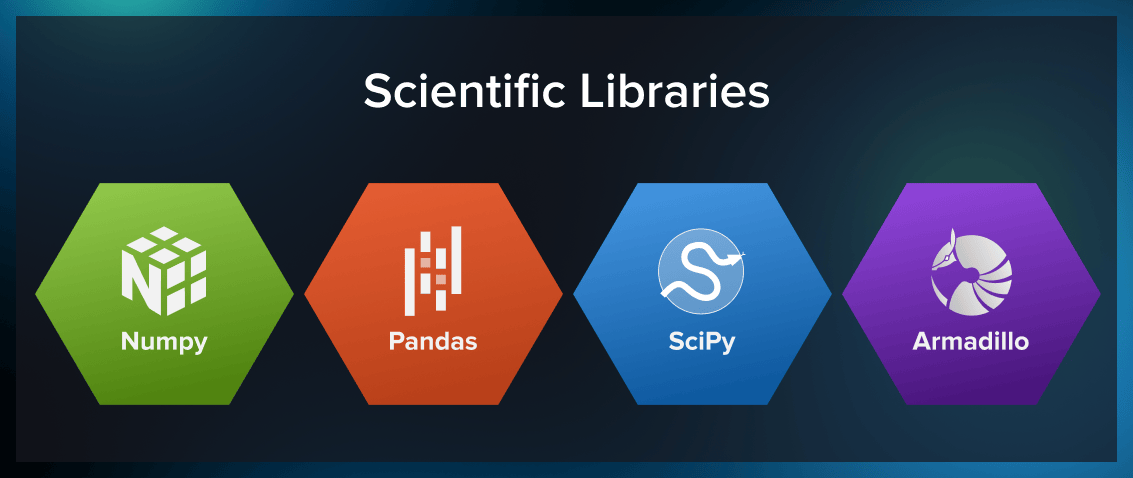
If you’re involved in scientific computing or AI research, your job includes building mathematical models, performing quantitative analysis, and verifying hypotheses.
Let’s start by examining libraries that are specifically designed for performing mathematical operations and manipulating data using matrices and arrays. Libraries such as NumPy, pandas, Armadillo, and SciPy provide you with the necessary tools and speed up your work significantly.
NumPy
NumPy is an open-source Python library for arrays processing. It can execute algebraic, logical, and statistical operations over matrices and multidimensional arrays. The NumPy library is among the most popular Python tools for AI and data science computing.
NumPy stands for Numerical Python. As the name suggests, it is a library primarily intended for calculations. With it, you can save a lot of time when performing complex matrix operations.
What are the benefits of the NumPy library?
- A multidimensional container for generic data.
- A set of broadcasting functions: comprehensive mathematical operations, Fourier transforms, random number generators, linear algebra routines, etc.
- C/C++, Fortran integrations: NumPy can be used to work with code in other programming languages.
- The NumPy API is applicable to Matplotlib, Pandas, scikit-learn, and many other packages.
If you want to start with NumPy, watch this video tutorial for beginners:
Pandas
Pandas is the best option for handling tabular data and time series. This open-source library has a comprehensive list of built-in commands that save ML developers the need to write code specifically for certain mathematical operations. In addition to data manipulation, pandas also supports data transformation and visualization.
The library uses two main data structure types:
- Series (a 1-dimensional labeled data array).
- DataFrame (a 2-dimensional data structure).
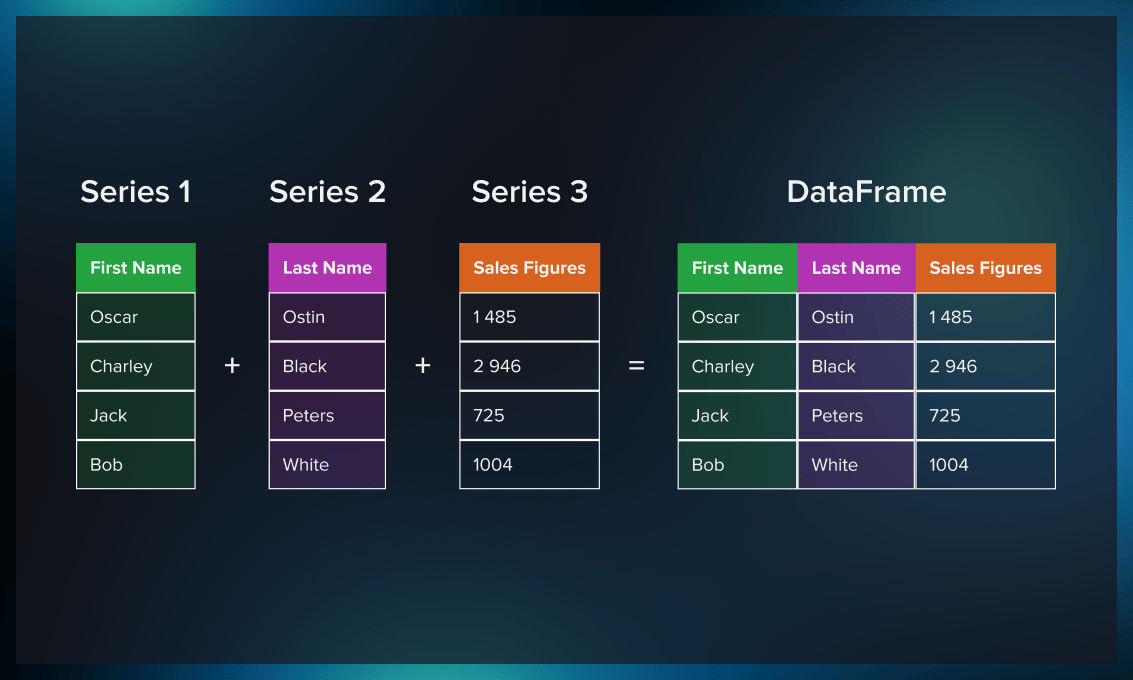
Pandas can import data from different file formats: JSON, SQL tables, comma-separated figures, etc. It’s also fast due to using highly optimized C++ code under the roof. So it can do tasks involving significant amounts of data much quicker than pure Python code, which is crucial in fields such as ML, finance, and data science.
Advantages of Pandas
- Pandas can help with multiple data processing tasks: grouping by syntax, combining data with other data frames, computing column correlation, providing rolling window calculations, etc.
- Pandas is a brilliant tool for feature engineering: customizable data transformation, normalization, scaling, etc.
- It’s considered one of the modern standards for representing multidimensional data.
- Data exploration capabilities: it’s a good tool for checking correlations in the data and can be used for cleaning data before applying a model.
SciPy
SciPy is a free open-source Python library designed to operate on NumPy arrays and is used for large datasets in scientific and technical computing. This ML library includes different modules for linear algebra operations, optimization, statistics, and integration.
SciPy offers a wider range of algebraic operations compared to NumPy and is generally considered to be more user-friendly.
What are the pros of the SciPy library?
- Easy, flexible, and relatively fast.
- Provides web and database routines for parallel programming.
- Includes high-level commands and classes for data visualization.
- Supports a wide range of scientific and engineering applications, including linear algebra, signal and image processing, etc.
- Has subpackages such as interpolates, ndimage, and fft.
- Supported by a rapidly expanding and engaged community of developers who regularly add new features and are readily available to respond to any questions or concerns.
If you want a practical step-by-step guide to SciPy, here is a helpful video tutorial designed specifically for those studying physics, mathematics, and engineering:
Armadillo
Armadillo is a C++ linear algebra library used for scientific computing tasks. Besides machine learning, Armadillo has applications in pattern recognition, signal processing, statistics, economics, and bioinformatics.
One of Armadillo’s advantages is its expression evaluator which combines multiple operations into one. The library provides high-level syntax and MATLAB-like functions. It can be used to develop ML algorithms in C++.
Important features of Armadillo
- Automatically runs OpenMP multithreading for accelerating computation-intensive operations.
- Comes with an intuitively understandable and straightforward interface.
- Provides support for: trigonometric functions, sparse and dense matrices.
- Supports several matrix decompositions via integration with ARPACK, ATLAS, and LAPACK. This accelerates the development process as it is less expensive to implement and more efficient to perform calculations.
C & Python data science libraries
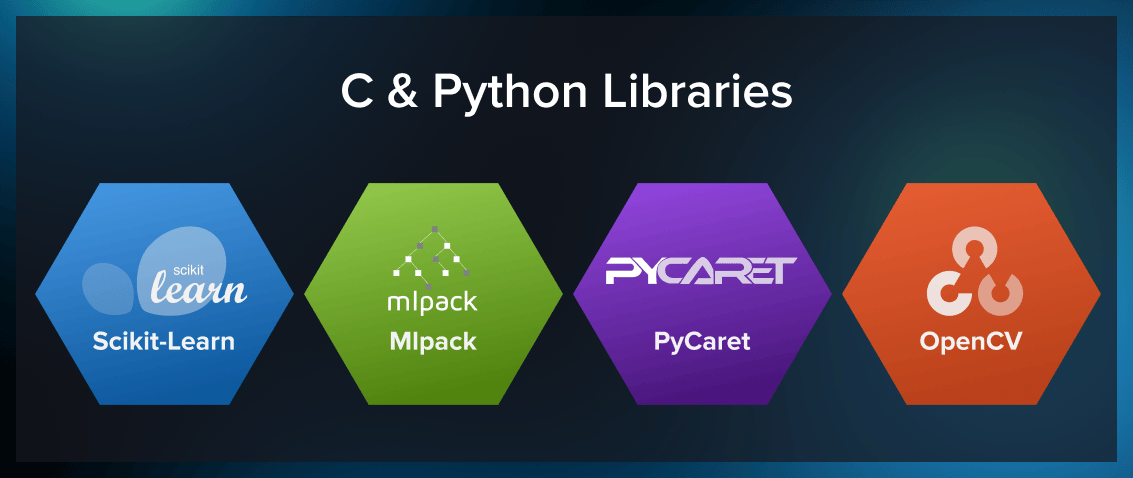
This section includes C and Python libraries specifically designed to facilitate the process of ML modeling. The following libraries offer a wide range of common ML algorithms and utilities that allow you to build and test models faster and more efficiently.
Scikit-learn
Built in C and Python, scikit-learn (also called sklearn) is one of the most popular ML libraries and has a worldwide community of programmers and IT specialists.
Scikit-learn is based on SciPy, NumPy, and Matplotlib, and is used for data mining and other ML applications. It includes a variety of widely used algorithms, such as SVM and decision trees. The library is also helpful for data preprocessing, BOW text vectorization, hashing vectorization, TF-IDF, etc. The only drawback of the scikit-learn library is that it does not provide adequate distributed computing support for applications in large production environments.
Why use scikit-learn?
- Easy to use.
- Numerous contributors and a broad international online community that supports and improves scikit-learn.
- Comprehensive API documentation.
To learn how to work with scikit-learn, watch this comprehensive video course.
Mlpack
Built on top of Armadillo, mlpack is a fast and adaptable ML library that’s written in C++. It provides fast and extensible implementations of complex machine learning algorithms. It also contains command-line scripts, Python and C++ classes, and Julia bindings that can be used in larger ML systems.
The library supports a variety of ML algorithms and models like Naive Bayes classifier, k-means clustering, logistic regression, Gaussian mixture models, Euclidean minimum spanning trees, etc.
What are Mlpack’s strong points?
- Contains comprehensive and robust tools for plotting.
- Allows for a detailed, in-depth data analysis.
- Suitable for beginners.
- Has extensive documentation.
- Maximizes flexibility and performance for advanced users with the help of C++ features.
- Extensible to other programming languages.
- Supports recurrent neural networks with template classes for GRU and LSTM structures.
PyCaret
PyCaret is a low-code ML library that allows data scientists to conduct end-to-end experiments efficiently. Based on Python, it enables them to quickly transition from data preparation to model deployment with just a few lines of code. The library utilizes various machine learning libraries and frameworks, such as scikit-learn, XGBoost, Microsoft LightGBM, and spaCy.
What can PyCaret be useful for?
- Data preparation: offers automation for different segments of data preparation, including missing value imputation, one hot encoding, ordinal encoding, cardinal encoding, normalization, and transformation;
- Model performance analysis: provides 60 plots for evaluating and explaining model performance, enabling instant results without the need for complex code;
- Feature selection: includes feature importance, principal component analysis, removal of multicollinearity, and ignoring low variance;
- Feature engineering: allows for feature interaction, polynomial and trigonometry features, group features, bin numeric features, and combining rare levels.
OpenCV
OpenCV (Open Source Computer Vision) is a cross-platform library for computer vision and ML applications. Originally written in C, it can be used on many systems, from PowerPC Macs to robotic dogs. With the release of version 2.0, the library added a C++ interface to its traditional C interface. Most new OpenCV algorithms are now developed in C++, and the library also has wrappers for languages such as Python and Java to make it more accessible.
What are the best features of OpenCV?
- OpenCV contains over 2500 optimized algorithms, including a wide range of classic and cutting-edge computer vision and machine learning algorithms.
- It has an Apache 2 license, making it easy for companies to utilize and modify the code.
- It’s compatible with desktop and mobile platforms, including Windows, macOS, iOS, Linux, Android, FreeBSD, and OpenBSD.
- It has a vast community with plenty of active members.
What is the difference between OpenCV and TensorFlow?
While OpenCV excels in handling data, including resizing, cropping, and working with webcams, TensorFlow provides a wider range of options for object detection, such as different networks and algorithms. Combining TensorFlow for training and handling tensors and OpenCV for data manipulation makes for an optimal solution for object detection.
Neural network (NN) libraries
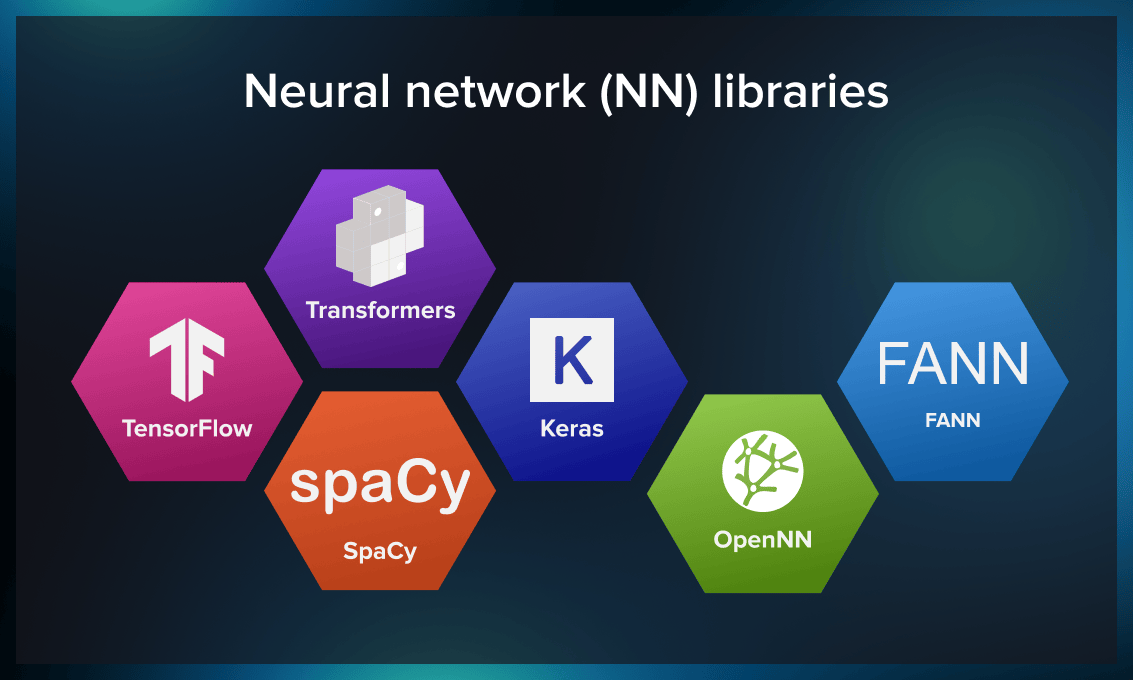
Neural network libraries provide open-source tools for research, development and implementation of neural networks and deep learning. The NN libraries discussed in this section – TensorFlow, Keras, OpenNN, SpaCy, and FANN – will help you test and analyze neural networks. Read on to find out about their features and benefits below.
TensorFlow
TensorFlow, developed by Google, is one of the best libraries for implementing deep learning models. The library offers excellent prototyping models capabilities and is a great quick-start solution for product-based companies. It includes Tensorboard, a web-based visualization tool that enables developers to view model parameters and performance.
What are the advantages of the TensorFlow library?
- Graphs: TensorFlow provides better visualization of graphs than other libraries, such as Torch and Theano.
- Google support: it benefits from fast updates, smooth performance, and regular releases of new features.
- Debugging: it facilitates the execution of a subsection of a graph, which gives it an advantage as we can add and retrieve discrete data.
- Scalability: Its ability to run on any machine and allows for designing a wide variety of industry-grade systems (for example, it was used by Airbnb, Snapchat, Dropbox, Intel, and Snapchat).
- Distinct methodology to measure various parameters and monitor the evolution of models during training.
Keras
Keras is an open-source library interface for TensorFlow designed for rapid testing of deep neural networks, including convolutional and recurrent neural networks. It helps programmers create models, analyze datasets, and visualize graphs.
It’s higher on the abstraction scale than Tensorflow and enables neural network training with a minimum of code. Keras also has multiple features for working with images and text. Due to its high scalability and flexibility, it’s used by many organizations, including NASA, Netflix, Yelp, and YouTube.
Why is Keras so popular?
- It can run on top of backends like PlaidML, Microsoft Cognitive Toolkit (CNTK), R, Theano, and TensorFlow.
- It provides a high-level, understandable set of abstractions to simplify the creation of deep learning models.
- It allows for fast deep neural network experimentation.
- It has exceptional community support, with individuals readily available to assist with any questions or inquiries regarding Keras usage.
Transformers
Transformers is a popular library for natural language processing, computer vision and audio-related tasks. These include language translation, text summarization, question answering, image classification, object detection, automatic speech recognition. etc.
It provides pre-trained models that can be fine-tuned for specific tasks using transfer learning, which can save a significant amount of time and resources compared to training a model from scratch.
What are the advantages of Transformers?
- Allows for efficient training of large language models.
- Utilizes parallel processing, thereby decreasing training time.
- Capable of comprehending the context of natural language sentences.
- Detects complex relationships within lengthy sentences.
- Simple and consistent API for working with different transformer models, making it easy to experiment with different architectures and compare results.
- Regularly updated with new models and features, making it a valuable resource for NLP researchers and practitioners.
- Has support for both TensorFlow and PyTorch, making it easy to use with existing codebases and libraries.
OpenNN
Open NN is an open-source neural network library for advanced analytics written in C++. The library is highly performant and has complex tools and algorithms for categorization, regression, prediction, and other AI solutions for neural networks modeling.
OpenNN has applications in chemistry, engineering, energy, and other fields. It contains non-linear processing units that can be implemented in any number of layers for supervised learning. It also includes data mining algorithms as a collection of features that can be added to other software products via an API.
What are the strengths of OpenNN?
-
High performance.
- CPU parallelization with OpenMP.
- GPU acceleration with CUDA (parallel computing and application platform).
- Can implement any number of layers of non-linear processing units for supervised learning.
- Contains data mining algorithms as functions integrated into other software tools through APIs.
FANN
Fast Artificial Neural Network Library (FANN) is a free, open-source neural network library developed in C. The library implements fully and sparsely connected networks for multilayer artificial neural networks. It is fast, adaptable, easy to use, and extensively documented. It has features like backpropagation training, cross-platform support, evolving topology training, etc.
What are the benefits of FANN?
- Provides a variety of GUIs, including Agile Neural Network, FANNTool, and Neural View.
- Supports more than 20 languages (Python, R, Rust, Erlang, Java, and others).
- Can store trained ANNs as .net files, enabling faster saving and loading of ANNs for future uses.
- Offers support for cross-platform execution of single and multilayer networks.
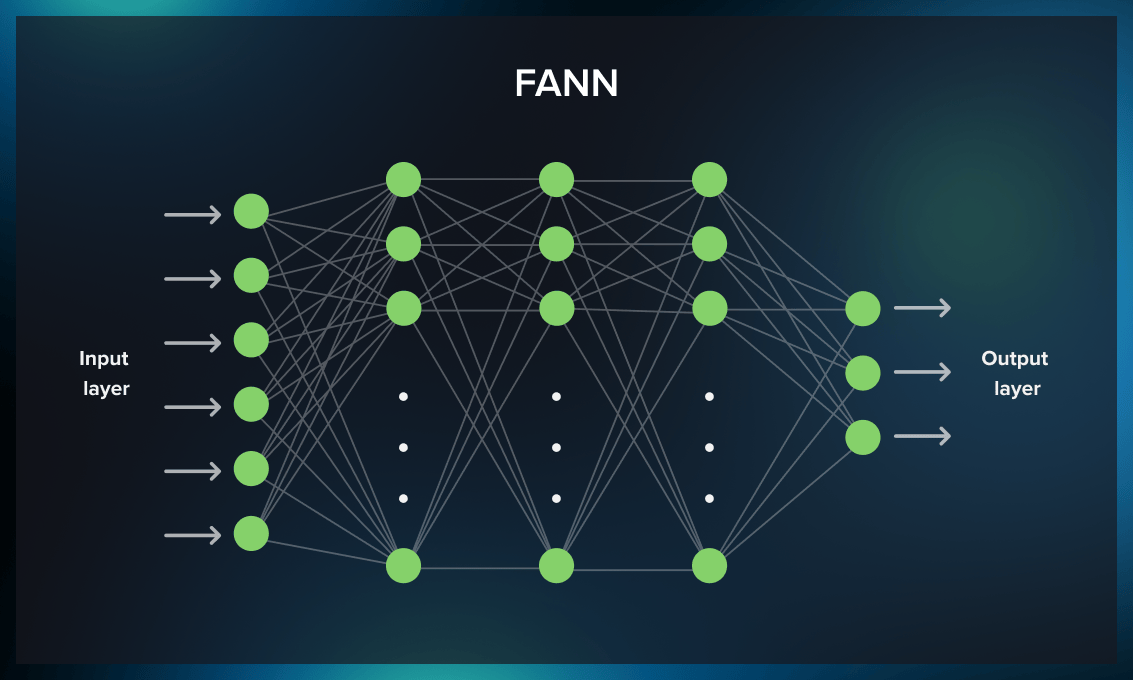
SpaCy
SpaCy is a Python library that offers advanced NLP capabilities and prepares text data for deep learning applications. It can process large volumes of text efficiently and is ideal for building models and applications for document analysis, chatbots, and other text analysis purposes.
This ML library was first introduced in October 2015. Now SpaCy, along with its expanding collection of plugins and integrations, offers a broad range of NLP functions, including extraction of phrases, merging noun chunks into singles, dependency parsing, etc.
What are SpaCy’s highlights?
- Fast processing speed: SpaCy is optimized for effective performance, making it suitable for real-time NLP applications.
- Pre-trained models for named entity recognition make it easy to identify and extract person names, organizations, locations, and more.
- Supports 72+ languages, including English, German, French, Spanish, Portuguese, Italian, Dutch, etc.
- A user-friendly API that makes it easy for developers to build NLP applications without having to write complex code.
- Can be easily integrated with other NLP libraries, such as scikit-learn, TensorFlow, and PyTorch, making it a flexible tool for natural language processing tasks.
- Designed to be production-ready, with good performance and stability in real-world use cases, making it a popular choice for language processing applications in industry and academia.
- Its strong community provides ample support for commercializing research advancements in this rapidly evolving field.
Graphics and visualization
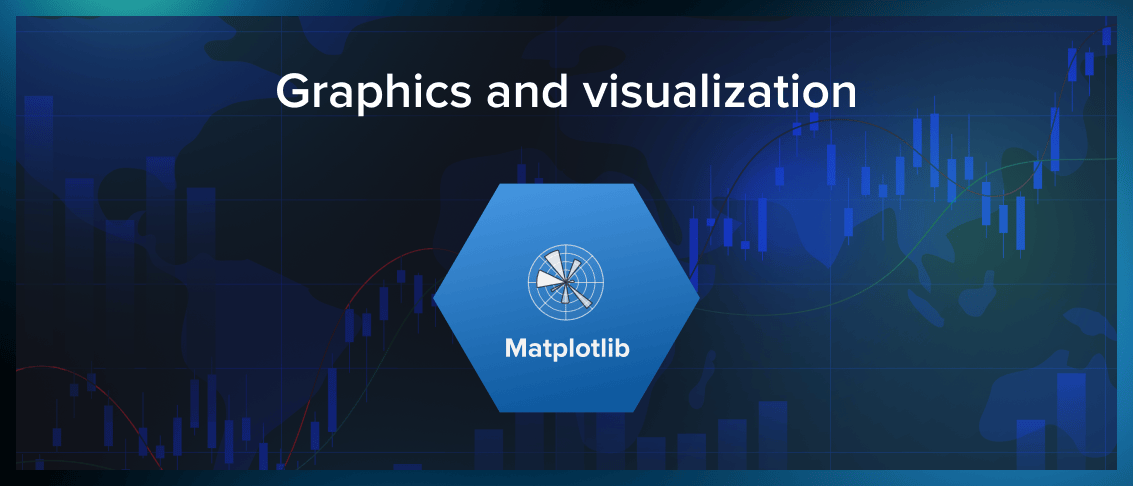
This last section of our list of the best machine learning libraries presents several tools that help developers and analysts accelerate their routine operations. These tasks include, among others, visualization of results by plotting graphs and collecting raw data for ML analysis using web scraping.
Matplotlib
Matplotlib is a Python open-source plotting library used to create a variety of plots and charts and primarily serves as a tool for developing static, animated, and simple interactive visualizations. It has features for controlling font properties, line styles, and formatting axes and provides a selection of graphs, error charts, bar charts, histograms, etc.
The Matplotlib library can create plots suitable for publication using Python GUI and object-oriented APIs. To integrate graphs and charts into programs, Matplotlib provides an object-oriented API using well-known GUI toolkits such as GTK+, Qt, and wxPython.
Is Matplotlib the best library for plotting graphs in Python?
Among charting libraries, Matplotlib is often considered the top choice by many users, surpassing Seaborn, Plotly or Bokeh. However, others may consider Seaborn or Bokeh as the best option. The table below provides a comparison of several criteria to help you make an informed decision about the best machine learning plotting tool for your specific needs.
Comparison of Python plotting libraries
| Matplotlib | Seaborn | Plotly | Bokeh | |
|---|---|---|---|---|
| Applications | Easily plots numerous graphs with Pandas and NumPy | As an extended version of Matplotlib, Seaborn uses Matplotlib, Pandas, and NumPy to plot graphs | A data visualization library built on top of Matplotlib to design data visualization in Python | Used for interactive visualizations for web browsers |
| Syntax | Imperative syntax: must explicitly specify each step in the process of plot creating |
Simple and easily learned syntax | Simple but requires time to learn numerous options | Declarative syntax: you have to specify the plot’s structure and the data you are going to use so Plotly can render the plot |
| Flexibility and UX | Highly versatile in its ability to create 2D and 3D plots for publication, primarily generating static plots with limited interactivity. It is capable of producing plots in a variety of formats and environments across different platforms. | Limited functionality with default commonly used themes for creating static plots and charts | Sophisticated data visualization tool for elaborate plots. It offers a web-based chart editor, which allows you to create and customize your plots using a graphic interface. | Enables designing of interactive plots and dashboards with hover-over effects, zoom, and pan across different operation platforms |
What are the best features of Matplotlib?
- Only requires a few lines of code to generate a plot for data sets.
- Offers great static data visualization: bar charts, scattered plots, graphs, etc.
- Customizable and extensible thanks to numerous features and configuration options.
- Cross-platform: can run on Windows, Linux, and macOS.
Conclusion
We have looked at the best ML libraries in 2023 that programmers and data analysts can use to simplify their jobs.
Here’s a brief recap:
- NumPy, pandas, SciPy, and Armadillo should be your preferred choice for scientific and technical computing.
- TensorFlow, Keras, Transformers, OpenNN, SpaCy, and FANN are best suited for researching and building neural networks.
- scikit-learn, PyCaret, and OpenCV are excellent for developing software solutions based on machine learning.
- Matplotlib is a source to tap into when it comes to plotting graphs and visualizations.
If you’re searching for ideas on how to use these libraries, check out our article with 10 great ML project ideas. And don’t forget to follow us on Twitter to stay updated about new articles we publish!





.jpg)
.jpg)
.jpg)
.jpg)